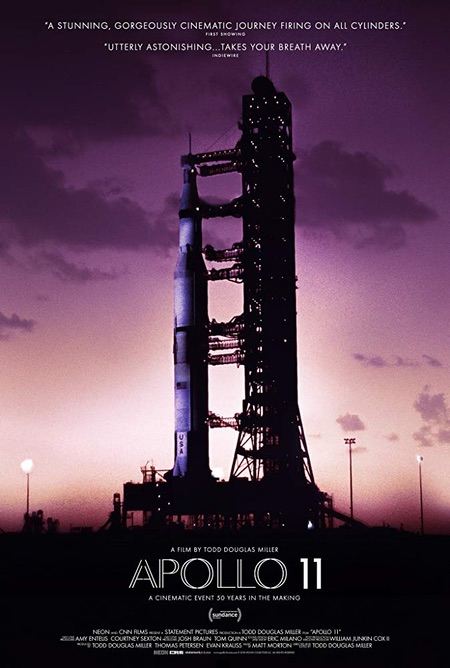Review: Review: Apollo 11by Jeff Foust
|
| “It's very hard to get archivists excited about things, and I get this email that’s filled with all these bolded words and exclamation points,” Miller recalled. |
Despite that mountain of footage—or, maybe, because of it—there are still new things to discover about the mission. That’s what the filmmakers of Apollo 11, a new documentary about the mission, found during their production of the film. They were scouring film from the movie at the National Archives, trying to be as comprehensive as possible in order to provide a complete story of the mission.
In May 2017, director Todd Douglas Miller got an email from someone at the National Archives. “It's very hard to get archivists excited about things, and I get this email that’s filled with all these bolded words and exclamation points,” he recalled after a screening of the completed movie last week at the National Air and Space Museum in Washington. That email said they had found some large-format film from Apollo 11, but with little information about what they contain. “Well, let’s take a look.”
When they got a look at a couple reels of that film, he said, “our jaws were just on the floor.” That footage was taken for various promotional efforts and a documentary, Moonwalk One, but has been left in storage for decades at the Archives, unseen, until that 2017 discovery.
One of the first people outside of the film’s producers to see the footage was Rick Armstrong, one of Neil’s sons. He noted at the screening that he was skeptical when he was first contacted by the filmmakers about the unseen film, but was intrigued when he heard it was large-format footage. His reaction to seeing it on Miller’s laptop? “Whoa, this is incredible.” Was there any part of it that particularly stood out? No, he said. “The whole thing was that way.”
Armstrong was among those who then got to see an early screening of the first 30 minutes of the 90-minute film. He came away impressed with what Miller and his team created. “It just made you feel like you’re watching it right now,” he recalled. “That was amazing.”
Another person impressed with the film was Buzz Aldrin. “As vivid as it remains for me,” he said of his recollections of the mission in a letter read at last week’s screening, “there’s not been a way to fully share that experience with everyone else, until now.” The documentary, he said, was not just another retelling of the mission, but also “a way to see it as I still see it in my memories.”
Apollo 11 started a one-week run in IMAX theaters in the US last Friday ahead of a wider theatrical release, and it’s worth seeing it on the very big screen this week. That previously unseen footage, along with more familiar views of the mission, are skillfully put together to create a vivid recollection of that famous mission that makes it seem new again.
| That new large-format footage is stunning, of course, but that way that it and other footage is combined is remarkable. |
The film is, in many respects, a stripped-down documentation of the mission. There is no dramatic narration, no cutaways to interviews with those involved or other talking heads who put the mission in to historical perspective. The movie starts with the rollout of the Saturn V to the pad—one of the first reels of that discovered footage screened by the filmmakers, Miller recalled—and goes through the mission to splashdown, recovery, and the post-mission celebrations.
That approach, though, immerses you into the mission, as familiar as it is to most people likely to see it. That new large-format footage is stunning, of course, but that way that it and other footage is combined is remarkable. One example is the final descent of Apollo 11’s lunar lander to the surface. Film of the lunar surface as seen from the lander is synced to the audio communications between the lander and mission control, while a display in one corner of the screen shows the altitude and fuel remaining. You know how it will end, but seeing the surface approach as the fuel runs low is dramatic.
There’s a strong attention to detail in the film as well. As Robert Pearlman, a historical consultant for the movie, notes, the filmmakers turned to technical documentation to determine exactly how the 1201 and 1202 alarms sounded during the lander’s descent: the alarms were heard only by Armstrong and Aldrin in their earpieces, and thus weren’t picked up in the recordings. In another case, the filmmakers, going through footage shot in the command module on the way back to Earth, picked up strains of music in the background from a cassette player. They traced it to a song called “Mother Country” by John Stewart, which now plays loud and clear in the movie.
That combination of technical rigor, new footage, and skilled filmmaking means that Apollo 11 is a wonderful film. It will still be good in regular theaters or even television, but the full effects comes from seeing it in IMAX, which makes it worth finding time in the next few days to see it there. It’s a reminder that the best-documented stories can still offer something new, even after half a century.
Note: we are temporarily moderating all comments subcommitted to deal with a surge in spam.
